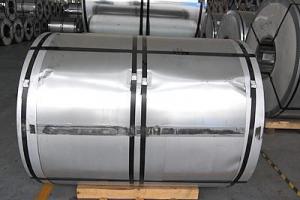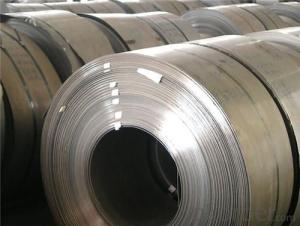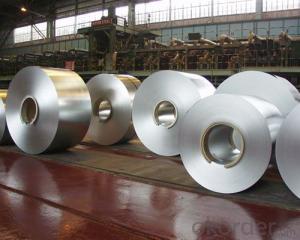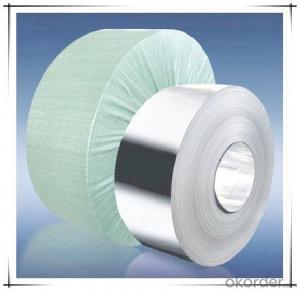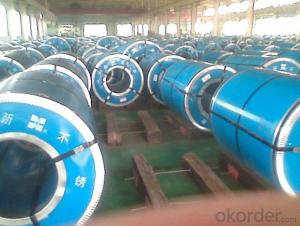PRIME QUALITY 430 STAINLESS STEEL IN COIL
- Loading Port:
- China main port
- Payment Terms:
- TT OR LC
- Min Order Qty:
- 20 m.t.
- Supply Capability:
- 1000 m.t./month
OKorder Service Pledge
OKorder Financial Service
You Might Also Like
Applications of Stainless Steel Coils:
1.Automotive:Automotive trim and molding/Difficult-to-form exhaust-system components, tubular manifolds, mufflers/Exhaust manifold and other exhaust-system components, catalytic converter shells, clamps
2. Construction: Gutters and downspouts, roofing, siding
3. Kitchenware: Cooking utensils, dishwashers, ovens, range hoods, refrigerators, skewers
4. Chemical processing: Oil refinery equipment, oil burner and heater parts
5. Appliances: Hot water tanks, residential furnaces
6. Power generation: Heat Exchanger tubing
7. Farming: Dry fertilizer spreaders/Farm animal pens
Technical notes:
Packaging & Shipping
Packaging is one of the best service of us, in order to prevent the damage from transit, our finished products are packaged carefully. All of our stainless steel sheet products will be transported with steel pallets or wooden pallets. Customers will be guaranteed that the product .they received from Ronsco can go directly into the production and out to the customers as finished product.
- Q:What are the different types of stainless steel strip edges?
- There are several different types of stainless steel strip edges that are commonly used in various applications. These include: 1. Mill Edge: This is the standard edge produced during the hot rolling process. It has a slightly rounded edge and may have some mill scale present. 2. Slit Edge: This edge is produced by slitting the coil into narrower strips. It is a straight edge with a smooth finish and no burrs. 3. Deburred Edge: This edge is created by removing any burrs or sharp edges from the slit edge. It provides a smoother and safer finish. 4. Rounded Edge: This edge is achieved by rounding the sharp edges of the strip. It is commonly used in applications where safety is a concern, such as in the food industry. 5. Beveled Edge: This edge is created by beveling the strip at a specific angle. It is often used in applications where a tight fit or welding is required. The choice of stainless steel strip edge depends on the specific application and the desired finish. Each edge type has its advantages and may be suitable for different purposes.
- Q:Can stainless steel strips be used in automotive exhaust systems?
- Yes, stainless steel strips can be used in automotive exhaust systems. Stainless steel is a popular material choice for exhaust systems due to its high corrosion resistance and durability. It can withstand extreme temperatures and harsh conditions, making it suitable for the exhaust system's demanding environment. Stainless steel strips are often used for the construction of exhaust pipes, mufflers, and other components due to their strength and ability to resist rust and corrosion. Additionally, stainless steel strips can be easily formed, welded, and shaped to meet the specific requirements of an exhaust system, making them an ideal choice for automotive applications.
- Q:Can stainless steel strips be used for electrical conductivity?
- Yes, stainless steel strips can be used for electrical conductivity. While stainless steel is not as conductive as other metals like copper or aluminum, it still possesses a certain level of conductivity that allows it to be used in various electrical applications.
- Q:Are stainless steel strips suitable for heat exchangers?
- Yes, stainless steel strips are suitable for heat exchangers. Stainless steel has excellent corrosion resistance, high thermal conductivity, and good mechanical properties, making it a suitable material for heat exchanger applications. It can withstand high temperatures, resist scaling and oxidation, and is easy to clean, making it an ideal choice for efficient heat transfer in various industries.
- Q:Can 111 stainless steel strips be used in the pulp and paper industry?
- Yes, 111 stainless steel strips can be used in the pulp and paper industry. Stainless steel is widely used in this industry due to its corrosion resistance, high strength, and durability. It can be used for various applications, such as in the manufacturing of paper machines, screens, and other equipment that come into contact with corrosive chemicals and liquids used in the pulp and paper production process. The 111 grade stainless steel, also known as AISI 111 or S11100, is a low carbon variant that offers good weldability and resistance to intergranular corrosion. Therefore, it can be a suitable material choice for specific requirements in the pulp and paper industry. However, the specific application and conditions should be considered to ensure that the stainless steel strips meet the necessary mechanical and chemical properties for optimum performance.
- Q:Can stainless steel strips be used in architectural roofing systems?
- Yes, stainless steel strips can be used in architectural roofing systems. Stainless steel is a durable and corrosion-resistant material, making it suitable for use in exterior applications such as roofing. It offers strength, longevity, and a modern aesthetic, making it a popular choice in architectural designs.
- Q:Are stainless steel strips suitable for cryogenic applications?
- Yes, stainless steel strips are suitable for cryogenic applications. Stainless steel is known for its excellent mechanical properties, corrosion resistance, and thermal stability, making it a popular choice for various industries including cryogenics. Stainless steel strips can withstand low temperatures without losing their structural integrity or becoming brittle, which is crucial in cryogenic environments. Moreover, stainless steel is non-magnetic and has low thermal conductivity, which are desirable characteristics for cryogenic applications where heat transfer and magnetic interference must be minimized. Overall, stainless steel strips are a reliable and durable option for use in cryogenic applications.
- Q:How do stainless steel strips perform in seawater environments?
- Stainless steel strips are highly resistant to corrosion and perform exceptionally well in seawater environments. Due to their composition, which includes a significant amount of chromium, stainless steel strips form a passive oxide layer on their surface that acts as a protective barrier against corrosion. This oxide layer prevents direct contact between the steel and the corrosive elements present in seawater, such as salt and moisture. Furthermore, stainless steel strips exhibit excellent resistance to pitting and crevice corrosion, which are common forms of corrosion in marine environments. This resistance is primarily attributed to the high levels of chromium and nickel present in stainless steel. These elements enhance the steel's ability to withstand the aggressive nature of seawater, ensuring its durability and longevity. Stainless steel strips also have the advantage of being highly versatile and adaptable, making them suitable for various applications in seawater environments. They can be easily formed, welded, and fabricated into different shapes and sizes, providing flexibility in design and construction. Overall, stainless steel strips are an excellent choice for use in seawater environments due to their exceptional corrosion resistance, durability, and versatility. They offer long-lasting performance, minimal maintenance requirements, and can withstand the harsh conditions associated with marine applications, making them a reliable and cost-effective solution.
- Q:What are the factors affecting the weldability of 111 stainless steel strips?
- There are several factors that can affect the weldability of 111 stainless steel strips. 1. Composition: The chemical composition of the stainless steel strips, including the amount of carbon, chromium, nickel, and other alloying elements, can greatly impact their weldability. Higher carbon content can lead to higher susceptibility to cracking during welding, while the presence of certain alloying elements can improve weldability. 2. Heat input: The heat input during welding, which is a combination of current, voltage, and travel speed, can influence the weldability of stainless steel strips. Excessive heat input can cause the material to overheat, leading to distortion, loss of corrosion resistance, and even cracking. 3. Pre-weld and post-weld treatments: Proper surface preparation, including cleaning and removal of contaminants, is essential to ensure good weldability. Additionally, post-weld treatments such as annealing or stress relieving may be required to minimize distortion and reduce residual stresses that could affect the integrity of the weld. 4. Welding process: The choice of welding process, such as gas tungsten arc welding (GTAW) or gas metal arc welding (GMAW), can impact the weldability of stainless steel strips. Certain processes may require the use of specific shielding gases or filler materials to achieve optimal weld quality. 5. Joint design: The design of the joint, including the type of joint and its dimensions, can also influence the weldability of stainless steel strips. Proper joint design can ensure good fit-up and reduce the risk of weld defects, such as lack of fusion or excessive porosity. 6. Welder skill and technique: The skill and technique of the welder can significantly affect the weldability of stainless steel strips. Proper welding techniques, such as maintaining the correct arc length, controlling the heat input, and ensuring consistent travel speed, are crucial to achieving sound and defect-free welds. By considering these factors and implementing appropriate measures, the weldability of 111 stainless steel strips can be optimized, resulting in high-quality welds with good mechanical properties and corrosion resistance.
- Q:How do you clean and maintain stainless steel strips?
- To clean and maintain stainless steel strips, start by wiping them with a soft cloth or sponge soaked in warm soapy water. Rinse them thoroughly and dry them with a clean towel to prevent water spots. For tougher stains or fingerprints, use a stainless steel cleaner or a mixture of vinegar and water. Avoid using abrasive cleaners or scrubbing pads as they can scratch the surface. Regularly wiping the strips with a microfiber cloth will help maintain their shine and prevent buildup of dirt or grease.
1. Manufacturer Overview |
|
|---|---|
| Location | |
| Year Established | |
| Annual Output Value | |
| Main Markets | |
| Company Certifications | |
2. Manufacturer Certificates |
|
|---|---|
| a) Certification Name | |
| Range | |
| Reference | |
| Validity Period | |
3. Manufacturer Capability |
|
|---|---|
| a)Trade Capacity | |
| Nearest Port | |
| Export Percentage | |
| No.of Employees in Trade Department | |
| Language Spoken: | |
| b)Factory Information | |
| Factory Size: | |
| No. of Production Lines | |
| Contract Manufacturing | |
| Product Price Range | |
Send your message to us
PRIME QUALITY 430 STAINLESS STEEL IN COIL
- Loading Port:
- China main port
- Payment Terms:
- TT OR LC
- Min Order Qty:
- 20 m.t.
- Supply Capability:
- 1000 m.t./month
OKorder Service Pledge
OKorder Financial Service
Similar products
New products
Hot products
Hot Searches
Related keywords

